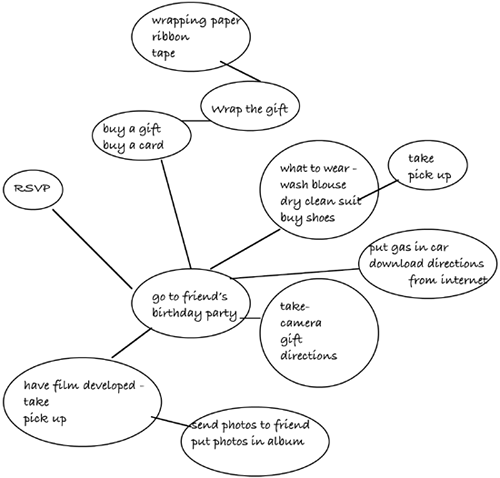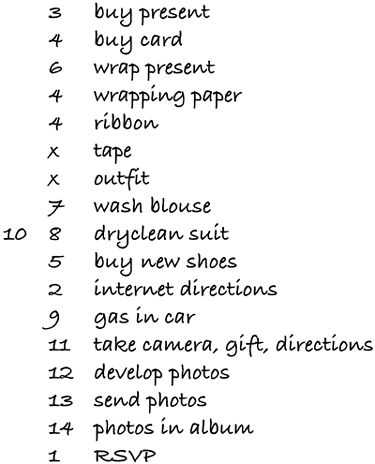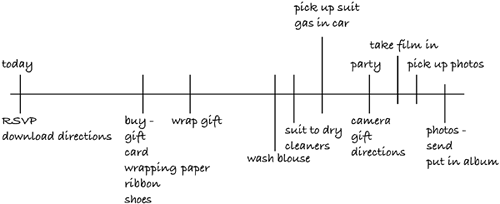Following Through After the Activity or Event
The last component of any
activity—the wrapping up, cleaning up, putting things away, enjoying the
accomplishment part—is the one most overlooked and neglected by people
who tend to be disorganized. These people's creative tendencies find the
last step boring or superfluous. They want to get on to exciting new
projects.
But this last step is
critical to a smooth-running schedule and a less frazzled life.
Suitcases need to be unpacked; paint brushes must be cleaned; library
books (and especially rented videos) must be returned. And nothing will
destroy the benefit of a restful vacation quicker than having to head
back to work the next day and face a full schedule of meetings and
report deadlines along with the post-vacation pile-up of mail, phone
messages, and email.
If you're pressed for
time, you certainly won't see as much urgency in cleaning up as you
will in moving on. But if you take the time to wrap things up, you'll
find you can live in the present with a good outlook to the future
instead of feeling as though nothing is ever quite accomplished. Don't
lose sight of your reason for wanting to organize your family's
schedule: to reduce your stress and increase your enjoyment of life. If
you won't go the final step without a reminder, then schedule the
wrap-up as a separate item on your to do list.
In general,
asking yourself the following questions will go a long way toward making
sure that you schedule all the follow-up steps to wrap up an activity
so that you feel satisfied and don't have a nagging feeling of
incompleteness:
- Is there anything to clean up?
- If yes, when will you clean it, and how long will this task take?
- Is there anything to put away?
- If yes, when will you put it away, and how long will this task take?
- Are there any follow-up activities, such as having photos developed or writing thank-you notes?
- If yes, when will you do them, and how long will they take?
note
The highly
acclaimed Montessori instruction method teaches how to do things by
breaking down tasks into their smallest components.
- Do any other people need to be involved in the wrap-up of this activity?
- If yes, when will they be available?
- Is there anything else you can do to make this activity more complete?
As
we've explained, every task you do has three parts to it: setting it
up, doing it, and wrapping it up. For some people this entire three-step
process is seen as one seamless event. These are the people who never
leave the board sitting out after the game is over because, to them,
putting the pieces away is all part of playing the game. These people
are never left with paint-encrusted brushes or unpacked suitcases
either. If some of the people in your family have brains that work this
way, you should be aware that you can allow them to maintain their
schedules in a less-detailed way. For
other people, playing the game ends when someone has won. Putting the
board away is an unrelated event. For these people, other events unto
themselves include cleaning the paint brushes after the garage is
painted and unpacking suitcases after a vacation. If some of the people
in your family have brains that work this way, you should be aware that
they will need to maintain schedules in much more detail. There's
no universal right or wrong amount of detail in a person's schedule.
It's all about what works for each individual. As long as your family
members are aware of individual differences as they organize the
family's schedule, they will be able to do their part to keep family
life running smoothly. |
|
Creating and Using To Do Lists
You probably make
lists of things to do all the time. But do they serve their purpose, or
are you often left at the end of the day with a list of things you
didn't do? To create an effective to do list, you need to have an
understanding of everything you want to accomplish within a certain time
frame. Then, for each item on that list, you need to make a
separate list of all of the component tasks involved in completing that
item. You can make that list by following these steps:
1. | State the main activity.
|
2. | List everything that needs to be done to prepare for the task.
|
3. | List everything that needs to be done to complete the task. Use the questions listed in the last section to help you.
|
Your list doesn't have to be a
numbered series of items going down a page. As an alternative to
writing a list, you can draw an activity map, such as the one shown in Figure 1.

Just breaking down
the activity into its components isn't enough, though. Each component
has to be completed in its correct order, so the next step in using your
list is to put the steps in sequence. If you've made a list, you can
assign each line a number or numbers indicating your planned chronology,
as shown in Figure 2.
If you prefer more visual tools, such as the activity map, then you may
also prefer sequencing the steps by using a timeline, as shown in Figure 3.


After you've put the steps
in order, you still have one more phase to go in the planning process.
That's to schedule the steps into your planner. Only after each step has
been assigned a time slot during which it will be performed have you
succeeded in establishing a plan that, if carried out, will get the job
done in an orderly and unharried way.
In
our example of the friend's birthday party, you may have noticed that
some items were grouped together during the sequencing phase of the
planning. They were grouped together strategically to make more
efficient use of time. We mentioned earlier how an interruption takes
time not just for the interruption itself but also for the time required
to shift attention to the interruption and then the time needed to
shift attention back to the original task. Everything you do has a
wind-up time and a wind-down time. Sometimes
these chunks of time are barely noticeable—for example, every time you
sit down to do desk work and then shift away to do something else. In
our example, you can see that we grouped replying to the invitation and
getting the driving directions together, even though the directions
wouldn't be needed for quite some time. However, because they were both
desk activities, there is a small savings of time involved in
approaching the activities this way. Sometimes
these chunks of time are obvious—for example, in the case of errands,
where you have to spend the time to drive to the shopping center and to
drive back from the shopping center. One trip, obviously, takes less
time than two trips. That's why in the example we've lumped the shopping
together as much as possible. Why,
you may ask, if this consumption of extra time is so obvious, don't we
avoid it naturally? The answer is that sometimes we do. But sometimes
lack of organization gets in our way. In other words, the more
disorganized we are, the less efficient we are. The less efficient we
are, the more disorganized we become. So, we get caught in a spiral of
disorganization. One reason you may not group your errands together is
that you don't remember that some of the errands need to be done. This
reason is the result of a failure to plan properly. Another reason is
that you may have scheduled your activities too tightly, so although you
may have time to get to the dry cleaners to pick up your dress, you
don't have enough time to also stop at the drugstore for toothpaste.
This means that because you don't have 10 minutes to buy toothpaste now,
buying toothpaste tomorrow will take you 30 minutes. To get a greater
appreciation of how defragmenting your tasks can save you both time and
money, compare the two scenarios in Table 1. Table 1. Buying Milk and Cereal| Scenario 1: Two Trips | Scenario 2: One Trip |
|---|
| | Time | $ | | Time | $ |
|---|
| Drive to store (avg. 3 miles) | 10 | 1.00 | Drive to store (avg. 3 miles) | 10 | 1.00 | | Walk through ice cream aisle to milk
(Stop and get ice cream) | 2
1 | 2.50 | Walk through ice cream aisle to milk
(Stop and get ice cream) | 2
1 | 2.50 | | Pick up milk | 1 | 2.00 | Pick up milk | 1 | 2.00 | | Walk through cookie aisle to checkout
(don't get cookies because you got ice cream) | 1 | | Walk through cereal aisle to checkout | 1 | | | Wait in checkout line | 3 | | Pick up cereal | 1 | 3.00 | | Check out | 4 | | Wait in checkout line | 3 | | | Drive home | 10 | 1.00 | Check out | 4 | | | Drive to store | 10 | 1.00 | Drive home | 10 | 1.00 | | Walk directly to cereal aisle | 2 | | Total | 33 | 9.50 | | Pick up cereal | 1 | 3.00 | | | | | Walk through cookie aisle to checkout
(Stop and get cookies) | 1
1 | 2.50 | | | | | Wait in checkout line | 3 | | | | | | Check out | 4 | | | | | | Drive home | 10 | 1.00 | | | | | Total | 64 | 14.00 | | | |
Organizing
your schedule pays. This example shows how you can save 31 minutes of
your time and $4.50 of your money by planning ahead and scheduling your
time wisely so that you make one trip to buy milk and cereal instead of
two trips. If you eliminated one trip to the store every week, you'd
gain more than 26 hours and save about $230 a year. |